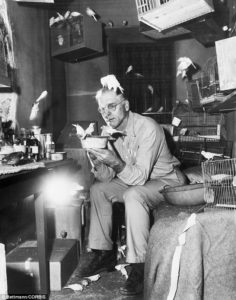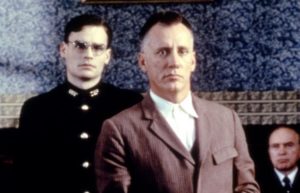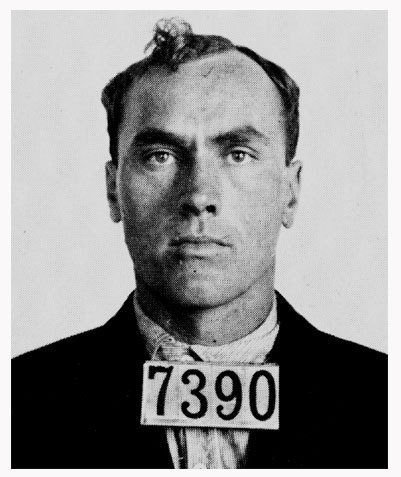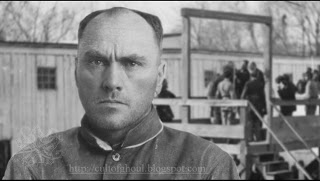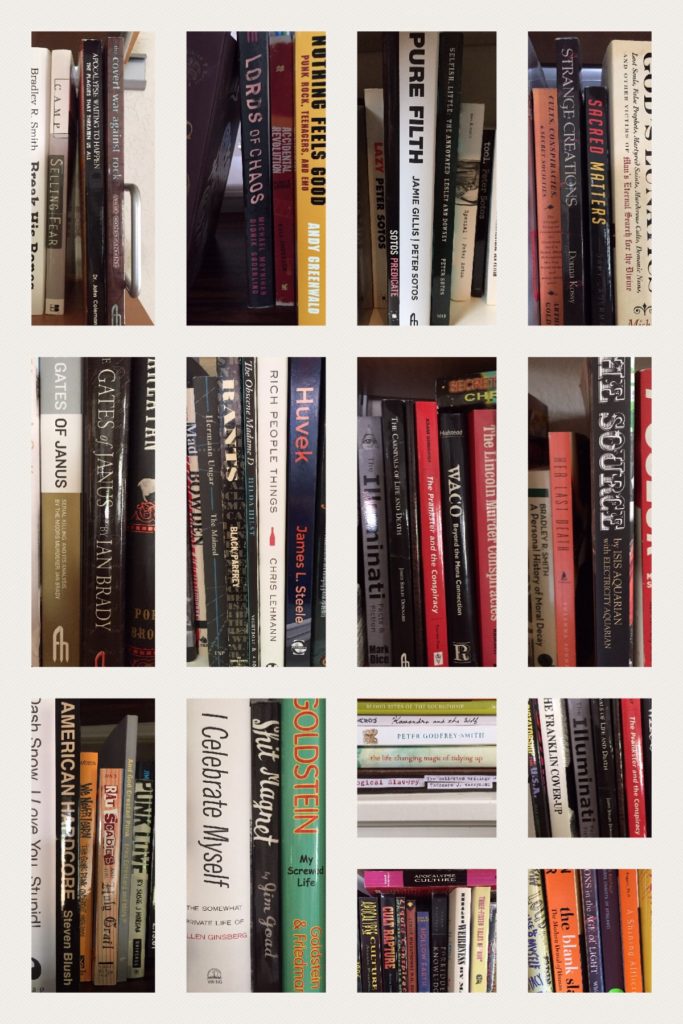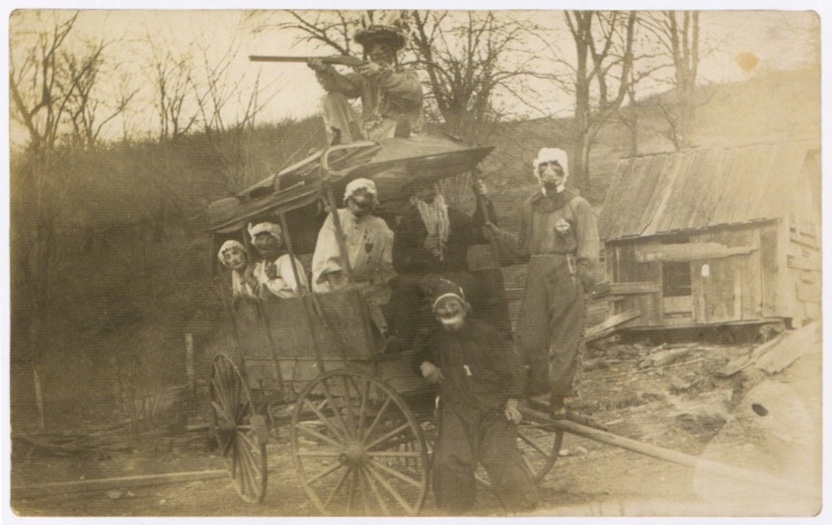Book: Leaves from the Smorgasbord
Author: Hank Kirton
Type of Book: Fiction, short story collection, flash fiction
Why Do I Consider This Book Odd: Because the collection begins with this disclaimer:
Most of these stories were written while I was either going through chemotherapy or locked in rehab. That might help explain things. Or not.
Availability: Published by Crumbling Asphalt in 2017, you can get a copy here:
Comments: Oh god, that disclaimer tore my heart into several pieces. And filtering these stories through that disclaimer ground those pieces up into a sort of heart hamburger. I don’t know Hank Kirton very well. I know him in that vague way many of us know each other – he read my site, I read his books, sometimes I see him on Twitter, I wouldn’t recognize him in real life though he might recognize me if I haven’t changed my hair in a while. But even though I don’t know him, I still know him because there are too many times his words have stepped off the page and recognized me and I waved back. Those words know me because Kirton and I share similarly strange cultural references. They know me because Hank Kirton writes in a way that gives shape to some of my thoughts, creating cultural links between unlikely ideas. There is a confluence of ideas, concepts, and milestones that happens when I read Kirton’s short fiction.
I still think of his story “Jelly” every time I hear Ulver’s “Nowhere Catastrophe.” Had Kirton heard that song before writing “Jelly”? Did it somehow influence him? It makes me wonder because the two pieces merge so seamlessly, a story and a song about human transformation into music, the written and musical notes at the end of a transfiguration. Because he is able to tap veins so similar to my own, I think of Hank Kirton, the Writer, several times a month. Which is awful because as I consider him in his role as the Writer, I had no idea he was suffering as Hank Kirton, the Human Being. I know now. I have the physical representation of his time in hell right here in front of me, waiting for me to finally discuss it. I keep putting it off because this year is the decade anniversary of my own time in hell, a different sort of hell than Kirton’s but similar enough to show me that, again, I know Kirton, in the most miraculous and miserable ways possible.
Leaves from the Smorgasbord is a collection of 32 stories but is only 181 pages long. Kirton is a master of flash fiction, but routinely nails longer stories, too. This collection begins with “Hello,” a story about a desperate fifteen-year-old girl reaching out for help as she experiences a bad acid trip. She randomly dials a number in the middle of the night, and reaches Don, a 47-year-old Asian man who is sufficiently alarmed and kind enough to stay on the line with the frightened teen until she feels settled and safe. Then the rug gets abruptly pulled out from under the reader with a nasty slap in the face. When I finished this piece I recalled Johnny Truant’s story of salvation in House of Leaves that turned out to be a lie that any astute reader understood was a lie. I missed the lie and had a warm feeling of relief, that Johnny, strung out and without tether, was finally going to be okay. At the end of that lie and “Hello,” I felt the same sense of “how the fuck can I, an adult in Current Year, still buy into and feel comforted by treacly examples of human beings at their best?” But I do. And it still feels bad when my faith in mankind is tested and mankind fails. But this story is also pretty much a fantastic way to begin a short story collection written by a man who was undergoing chemo or detox as he wrote it. Goddamn it.
This story was strange for me because it was short, consisted solely of dialogue, yet I felt like I knew Don at the end. I had the sense that even though there was no way I could really make such an assertion, Don was the sort of man who, even after being set up for cruelty, would not hang up the phone should another person call in the middle of the night, needing someone to talk to. I don’t think Don was ultimately bothered much – he was probably just relieved to learn no one was really in any sort of trouble. Don is sort of a placid lake onto which tiresome stones were skipped but ultimately his surface would smooth out once more. Don is a stable mooring to which the other stories are secured, keeping the reader from drifting out into a miserable sea of bad, baffling and surreal behavior.
Hank hits way too close to home for me with “Blimpo Saves.” It’s 1971 and Neal, a stoner up way too early on a Sunday morning, eating a bowl of Frankenberry cereal, is watching a Christian cartoon wherein a blobby clicking atrocity brings the love of Jesus to the children unlucky enough to be awake and watching television before the sun comes up on the Sabbath. Neal becomes increasingly disturbed by Blimpo. The kids in the cartoon translate Blimpo’s weird clicks but Neal senses that there is some sort of unholy Morse code behind the clicks, and Blimpy triggers a paranoia I’m so completely familiar with.
Blimpo says, “Click-click clickety click. Click click click!” and Neal shivers as if he’s just heard his own epitaph. The kids translate: “You don’t have to be scared of God’s love. It will protect you.” They say this to a frightened cartoon puffin named Paul.
Then Neal wonders if the kids translating Blimpo are actually Satanic minions, a reasonable conclusion to reach.
Neal begins to resent Blimpo for giving him The Fear. He decides Blimpo is a misguided messenger for Christian deliverance. Those clicks of his are jive, he tells himself, mere jive, but this notion offers no consolation. He wants to change the channel but is afraid to move. He feels hypnotized by Blimpo’s clicks, his swollen ping-pong eyes.
Neal’s feelings about Blimpo closely mirror my own about Jon Konrath’s fine lunacy. But I also know what he means about Blimpo, a gross Christian pablum panderer that I sense may be based on the eerie and unwholesome JOT.
Did you ever see a JOT cartoon before you had the vocabulary and life experience to explain why watching it felt so very, very wrong? God, that thing was absolutely horrible, but at least Jot could speak. And actually, now that I think about it, clicking would have been better than that chirping voice that shows that the Uncanny Valley can have an audio component.
When I was a kid, there was a locally-produced show in Dallas that came on before church called The Children’s Hour. The host, a well-intentioned man, I am sure, entertained children in a Christian manner, showing Christian cartoons and offering commentary. Puppets were involved. I am unsure what the goals of that show were but I suspect that they didn’t mean to plant seeds that bloomed into atheism. But what sort of lessons did they hope to convey, showing JOT, this minimalist biblical burden on children who don’t need to ponder the moral relativity of not getting dirty when they can’t even really speak properly yet? JOT was twitchy, man, with those hands (dirty or clean) that disappeared when he wasn’t moving. Where was his nose? Why didn’t his mother notice her small son had hands caked in mud, spit in a tissue and wipe him down before sending him off to Sunday school? Better yet, why didn’t the dumb creature just go back inside and wash his hands quickly before it was time for church? If he could open the door and get out into the yard, he could have gone back in and quickly washed his hands. But then they’d have had to teach us how dawdling made Jesus cry so there was really no way out of being taught a largely irrelevant moral lesson about how being a small child capable only of the thoughts of a small child was probably an affront to God. The only truth I could find was that devout children as portrayed in cheaply-made cartoons were very stupid.
